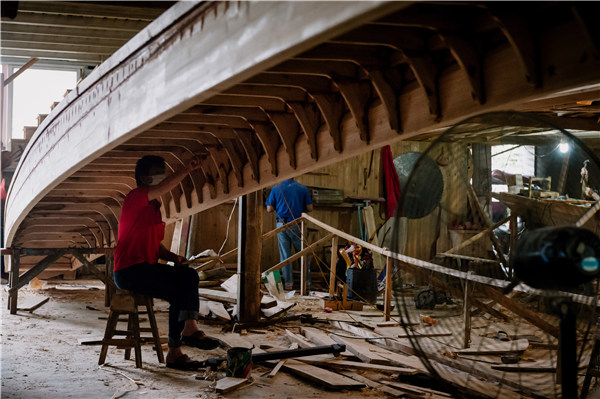 |
|
Fang Jianwei's family has carried on the boat-making techniques since the end of the Qing Dynasty (1644-1911) in Nantong in Fuzhou, Fujian province. [Photo by Lin Cen/For China Daily] |
"For people working in other places, they can watch my videos if they are unable to get back for the festival," he says.
According to Yuan, in Jieyang, only three boats have dragon heads with a red face and white whiskers - two of the boats are old and no longer in use, while the other was built in 2012.
"It's rare and precious because local dragon heads are often seen with black, green or red whiskers," he says.
Located in Nantong town, Fuzhou, Fujian province, Fangzhuang village is well-known for its tradition of making dragon boats, with a history of over 700 years.
Fang Shaohuang is a third-generation inheritor of his family's dragon boat-making techniques, which can be traced back to the end of the Qing Dynasty (1644-1911). In 2018, the family's technique was enlisted as part of Fuzhou city's intangible cultural heritage.
Fang and his five brothers all learned these skills from a young age, and together they run the family's 1,000-square-meter boat-making factory.
However, among the next generation of his family, only his nephew Fang Jianwei will pick up the mantle.
"It's not a profitable industry. After a day of laborious work, you are covered in dirt and sawdust from head to toe. Young people can't endure hardship and they have better job opportunities," says Fang Jianwei, 30, who has been learning how to build dragon boats for 10 years.
He says it's important that more people, especially youngsters, know about these traditional techniques.
Kuaishou has turned out to be a good channel to promote their boat-making skills.
This year, Fang Jianwei started to post videos of him and his team hard at work on Kuaishou. He now has over 1,100 followers and often communicates with boating fans up and down the country. It also gets him orders from places further afield.
He doesn't reveal the number of annual orders they receive. But he says sales have been dropping a bit in recent years after a few years of steady growth.
"It's probably because young people are not as interested in rowing dragon boats as they once were. It's tiring and can be a sweltering sport to take part in, under the summer sun," he says.
Their boats are 23 meters long, and can accommodate 32 paddlers, a drummer, a gong player, a helmsman and space for someone to set off firecrackers from the bow. The cost is around 20,000 yuan ($2,900), and 80 percent of their customers come from Fujian province.
In the two months leading up to Dragon Boat Festival, the team becomes increasingly busy and often works from 5 am to 9 pm. During the slack season, they prepare materials such as fir wood.
In the past, almost all of the work was manual, but they now use machines such as an electrical saw and drills that help to speed up the process.